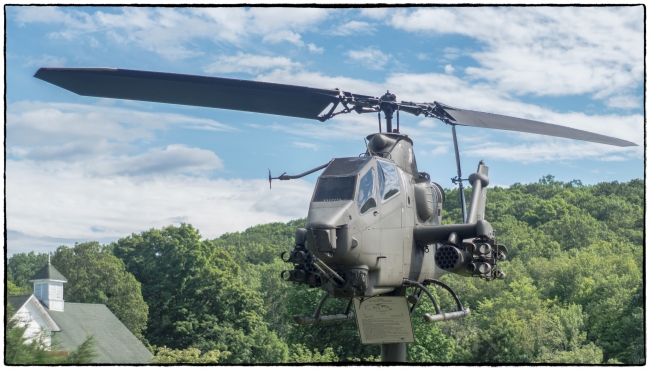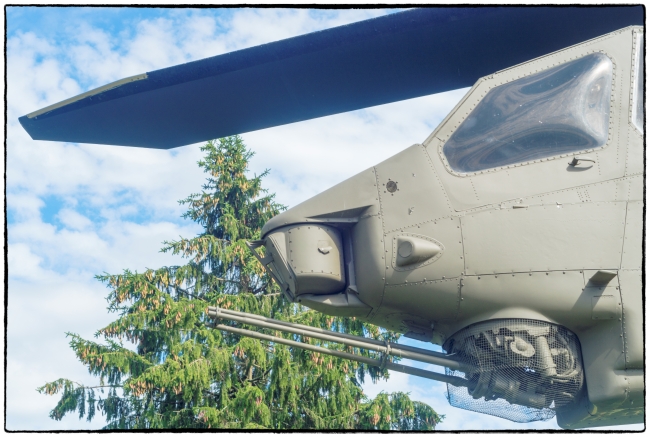After the 4-H Fair we went down to adjoining Veterans Memorial Park, where they have a number of exhibits, memorials, an outdoor gymnasium and a small museum. Above, one of the exhibits: a Bell AH-1 Cobra.
Military-Today.com the has this to say about the Bell AH-1 Cobra.
In 1965 Bell flew the prototype of the world’s first dedicated attack helicopter. This machine was specially designed as an escort for troop carrying helicopters to meet a US Army requirement. The whole development was completed in very short terms. Eventually this machine was a turning point in the development of helicopter technology and its application. This armored gunship was a step forward from the previous transport helicopters, that carried only defensive weapons. It opened a new era in warfare.
Based on the Bell Model 204 (UH-1D) utility helicopter, the Model 209 introduced a new slim fuselage with a fighter-type cockpit. The pilot sits high in the rear with a co-pilot/gunner lower in the front directing the fire of a wide range of weapons mounted on lateral stub wings or under the nose. The US Army liked this machine and the first order was placed in 1966. The new helicopter was designated as the AH-1G. Production commenced during the same year. The Cobra first saw service in 1968. Over 1 000 AH-1Gs were delivered in the first four years. This helicopter is often called the Huey Cobra. It saw extensive service in Vietnam. Furthermore it was one of the most valuable US weapons during that war.
Even though the AH-1 is based on the UH-1 Iroquis, little in the appearance of the Cobra shows off its roots. Engine and transmission were borrowed from UH-1. The original version of the Cobra was powered by a single Lycoming T-53-L-11 turboshaft engine, developing 1 100 shp. This helicopter has a narrow fuselage and was specially designed to be as small target as possible to enemy ground fire. Due to the streamline shape and lighter weight, the original version had a top speed of nearly double that of the transport helicopters that it escorted. Also this gunship was extremely maneuverable. This helicopter had simple but tough landing skids, rather than complex retractable undercarriage.
Under the nose there was a turret, that could mount miniguns, cannons, or grenade launchers. The turret could pivot to both sides of the helicopter, as well as up and down. The turret was controlled by the gunner, seated at the front. Also the pilot in the rear could fire the turret, if it was locked in the forward position. Early Vietnam models were armed with single or twin 40-mm automatic grenade launchers, or twin 7.62-mm miniguns. On second-generation models it was replaced by a harder-hitting 3-barrel rotary cannon.
The Cobra could carry 998 – 1 360 kg of weapons on its stub wings. Early production helicopters were fitted with up to four pods with 70-mm unguided rockets. These were effective against unarmored targets and light vehicles. The helicopter could also carry BGM-71A TOW anti-tank guided missiles, as well as other weapons. During the Vietnam War, the AH-1 took over the role of assault helicopter and tank killer from the UH-1D. It was flying anti-armor mission and was often used to ambush enemy columns.The pilot sits in the rear seat, which is slightly elevated above the front seat of the co-pilot/gunner. The front seat also has a full set of flight controls. The cockpit is surrounded by a light armor protection.
Soldiers on the ground contact the pilots via radio and coordinate the enemy positions.Initially in the mid and late 1960s the US Army planned to obtain a proposed Lockheed AH-56 Cheyenne attack helicopter. So only a relatively small number of the Huey Cobras was obtained. But when the Cheyenne program was cancelled Bell started work on improved models of the Cobra. Improved models were fitted with two engines. The US Army eventually retired its AH-1 helicopters in favor of the Boeing AH-64 Apache.
Overall Bell produced more than 1 600 first generation, single-engined Cobras, including variants. Later models were progressively improved in the key areas of engine power, performance and armament. In the 1970s twin-engined versions replaced the first generation, single-engined Cobras. Both single- and twin-engined Bell Model 209s have been widely exported. This helicopter was license-produced in Japan by Fuji-Bell.


